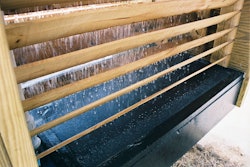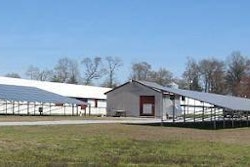The attics of modern poultry houses are insulated to keep heat from leaving the broiler house through the ceiling during cold weather and to keep solar heat from getting into the broiler house during hot weather. When the sun is out, attic temperatures can rise to well above outside temperatures. Researchers at the University of Georgia are using the energy trapped in the attic to help lower fuel costs for broiler growers.
Attic inlets have been used in livestock and poultry buildings in countries with cold climates for years as a means of tempering the air drawn in from outside before it comes into the part of the house where the animals are. Some livestock building are constructed with inlets in the attic eaves which allow outside air to be drawn in and inlets in the ceiling in the middle of the house which allow the air to be pulled into the area where the animals live. In some ventilation systems the inlet in the eaves and the inlet in the middle of the house are connected by ductwork, but in others the two vents are not connected. A potential disadvantage of systems that do not use ductwork to connect the inlets can be condensation forming and settling out on top of the insulation in the attic.
In the University of Georgia study, attic inlets attached to the chicken house ceiling pull hot air down from the attic space. Attic inlets can provide improved air and litter quality while saving money on heating, according to Michael Czarick, University of Georgia Cooperative Extension engineer. Attic inlets can be used year-round but are used most in the winter. During milder months, "if we have baby chicks and its 80 degrees outside, we still may need to add a little heat to maintain 90 degrees," he said. In the summer, after chickens are a week or two old, the attic inlets are generally closed to keep the houses cooler. At this point, growers use either conventional sidewall inlets or tunnel ventilation.
In the University of Georgia study, adding attic inlets to an existing 50 feet by 500 feet house costs around $1,800 and putting them in new construction would add around $1,200 to the cost of the house. One Georgia broiler grower who participated in the study said that the gas saved on the house with inlets was enough to pay for the inlets in two flocks.
"It's solar energy," Czarick said. "We're getting energy for free, reducing fossil fuel use and not dumping greenhouse gases. Fuel prices are getting too high and margins too narrow to not take advantage of this."















